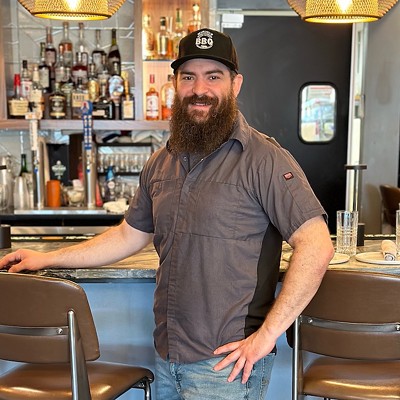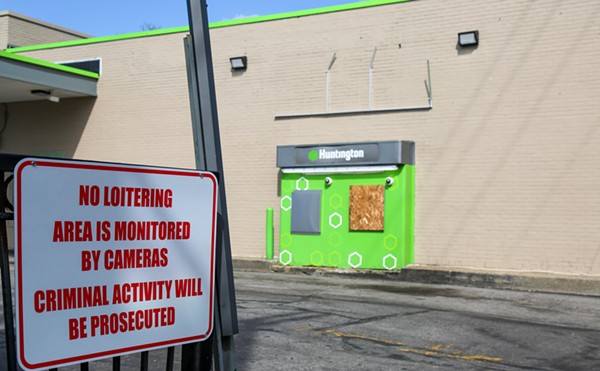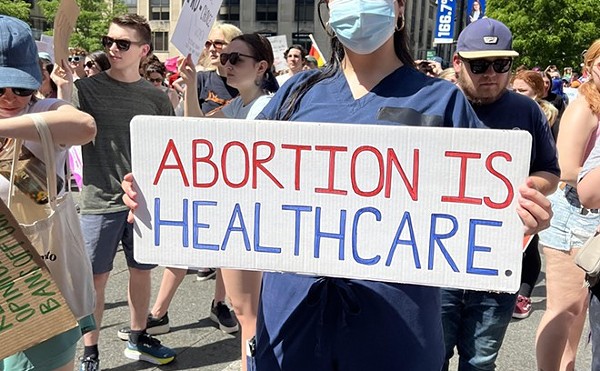Daisun Santana owns CityBreaks Studio in the heart of Clark-Fulton (3327 W. 32nd St., citybreakscle.com). His building, covered in colorful graffiti, speaks a profound message about the ability of art to help build and sustain neighborhoods. Santana is the one guy in Cleveland really carrying the breakdancing mantle these days, so he's got plenty of knowledge from the hip-hop scene. We met in his studio to talk about the art form and the lessons Cleveland might be able to draw from the elements of hip-hop.
You talk often of building up neighborhoods. How long have you been teaching dance in this neighborhood?
I was raised in Cleveland. I got into dance because of my father. But he was more a popper. It was just always around me. I didn't start breakdancing until I got to Lincoln-West High School. There was a whole bunch of kids there, and I was actually one of the last kids to start dancing. Over the years, I was learning and learning and traveling to different places. People started to quit, so I'm like one of the last of the Mohicans, you would say. I've been here for 12 years now, actively competing and living it as a lifestyle.
What about that lifestyle has kept you going?
The competition keeps me going. I used to go to Michigan, all over Ohio and the neighboring states. Then I went all over the world. The competitive aspect keeps me practicing hard. Any day that I'm not training, somebody in Japan, for instance, is training. You know what I'm saying? That competition got me to this level. The main thing here is that this is a place for me to practice. Before, it was very hard to find a place to practice, so I opened my own studio to teach and to share, but also for me have a place to train anytime I want.
What kind of students come to you? All ages, all walks of life?
Everybody. I have people who come from the suburbs — doctors at MetroHealth, lawyers, a range of different people.
About that idea of building up a neighborhood: Can you describe what you mean?
So I used to dance up at Lincoln-West High School and we used to walk all around here and around this actual building — it was abandoned years ago. People used to bust open the windows. Even when I first got it, it was really crappy. This whole area was dead. They had the boxing gym over there, but it was really tough around here. My brother owns the barbershop next door, so, me and him, we decided to turn this place around. I put colors into it, I put graffiti into it and everything. And since then, it seems friendlier around here now. Before, it was a lot more, ah, rugged. But now, as people notice the place and what's going on, they'll come in and ask questions. I'm trying to expose it more to the city. It's still kinda hidden.
There's a theory — nothing new, really — that art and artists are fundamental building blocks of young, thriving neighborhoods. Thoughts?
I used to live in Tremont, so I've seen that grow. Tremont was really crazy. People look at it now, and it's like, "Oh, it's really nice and artsy." But before, it was really crazy in Tremont. Over time, as artists would come and do their thing — culinary artists and stuff like that — they changed the game over there. I feel like here is the same thing. We're right in the middle of the 'hood, smack in the middle of this Spanish community. But by doing this, it kinda opens up possibilities. You know? And then you meet different people from other communities and you get that nice clash of communities.
Let's say I know nothing of breakdancing. And I don't. If I want to check it out, are you offering one-on-one lessons? Or how does it work here?
It depends. I like to teach one-on-one to make the student feel more comfortable. This is all still new. There aren't many breakers in the city. Well, there aren't any breakers in the city. It's really just me and my friends. I wouldn't expect anyone to be fully comfortable at first. Over time, if they prefer a group class, I do that as well. I'm still trying to get the recognition to sustain those big classes. In this city, this isn't something that everything really wants to take. I'm really trying to show the city that it's not just about dance. It's about self-expression and overcoming yourself and being confident or just learning something new that has rich culture involved in it. On Monday nights, we freestyle and have all our buddies come in and get down. So people can come in and get a feel for what it is.
You mentioned keeping at it because of the competition. But what got this art form started and what's kept it going all these years?
This dance form started in the 1970s. Before, it was just a dance up top and people were just groovin'. In the late 60s and early 70s, people were dancing to disco in the nice areas. But in the 'hood, people were dancing to James Brown and a lot of soul, funk. In New York, all the people that were into James Brown, they were moving differently than disco dancers.
The whole culture of violence back then was really crazy. It was poor, it was violent, and there was a lot of drugs. Just a lot of negativity. So this whole culture comes from hip-hop. B-boying, which is the original term for breakdancing, is one of the elements of hip-hop. And hip-hop is a multicultural movement that started in New York that was based on turning nothing into something, or taking the energy of negativity and bringing it into a positive light. So you had people that were in gangs. If I'm from the Bronx and you're from Queens, you couldn't come to my parties. Because then we were going to rumble. You've seen that movie The Warriors, right?
Yeah.
Well that movie was based on the story of hip-hop. That guy Cyrus was based on Afrika Bambaataa. He was the leader of Zulu Nation, the people who created the hip-hop movement. He was the leader of the biggest black gang, which controlled all the boroughs, named the Black Spades. He decided that he was tired of being negative, so he forced his old gang to be positive. In terms of, like, "Don't start nothing. Won't be nothing."
(The phone rings.) Sorry, one second. I don't know how to turn this off. Ah, got it.
So Afrika Bambaataa forced all the little gangs to also be positive. Whenever Zulu would throw their big parties, they would invite everybody from all the boroughs. That's what started the hip-hop movement. With dance, remember that if you're from a different 'hood, we'd be beefin' and we'd want to start a fight. He said that instead of doing that, there are different ways to handle your beefs through competition. In dance, the first ever battle came from breaking. The idea of a dance-off came from breakdancing. And not just breaking; they had graffiti battles. Like, my art's better than your art. Or I can spit better, like rapping. So rap is one element of hip-hop. The DJs and the graffiti art are other elements. And breakdancing is the fourth element. So we'd have our crew from the Bronx, your crew from Queens, a crew from Coney Island, all these different areas, and we'd all come to these Zulu parties. Instead of having a big rumble, we'd dance.
Over time, the DJs learned that they could loop music — before, they just used to play with one record. But they realized that everybody would get crazy at a certain part of the song, which is the break. That's when the person isn't singing anymore and the band is just going crazy. I'm getting goosebumps here. So the DJ realized that if he gets another turntable, he can loop the break, making the break longer so that everyone is going crazy for longer. Over time, it evolved to where he's not even playing the rest of the song. Now he's just playing breaks. A breakdancer is someone who dances to the break. It evolved to where all the dance moves were so much more energetic. People would go all the way down to the ground. They would do stuff with hand placements and try to remember certain moves. It was an evolution, but it came from the hip-hop movement. The whole idea is to turn nothing into something.
Cleveland in 2014 is certainly different than New York in the 1970s. What kind of lessons could Cleveland draw from hip-hop? What does Cleveland need?
Cleveland, for one, needs to be exposed to the real. They've seen what they've seen, and they're like, "Whatever." If they learned the history of it all, they would grasp what it really means. Cleveland needs to support hip-hop, so that hip-hop can do more for Cleveland. It can connect Cleveland with the world. In other cities, hip-hop is really prominent. You can feel it. You can walk in a city and feel the underground hip-hop scene. If Cleveland were to see and understand why this is here (gestures toward his studio) and what goes down in here, I feel like Cleveland would really understand hip-hop. And I'm not just saying it 'cause it's mine. But in here you can feel it all, all elements of hip-hop. And I want to expose the city to what hip-hop is worldwide. And there are other people who do it here, but it's more on a corporate tip. They're being funded by corporations. This is real. People who I work with are people who live it. It's not marketing. It's real life.
Another theory — also nothing new — is that there are "two Clevelands." There's one that's very wealthy with its restaurants and its corporate investments. And there's the other Cleveland that's not as wealthy, doesn't get positive attention in the press, and is fairly widespread. Cleveland is a diverse city. Can art — and dance, in particular — bridge those cities?
Yeah. That's the whole point of art — to bridge anything together. And with art, you can take it however you want. Art can definitely connect the two Clevelands — the three, four Clevelands — together, and everyone would have an understanding as to what they want to represent.
It's amazing to me that you've got the Cleveland Museum of Art, but then a few blocks away, up Euclid a bit, you get into a pretty poor part of town. And that part of town gets no positive press, but there are some terrific rappers and artists working there. Their stuff is benefiting that community, I'm sure, through education and creativity. But they get no attention from Cleveland.
I agree. Over here, it feels like the west side is starting to become like that. I see so many homes that are torn down. Just next door, I got this parking lot because there was a home torn down there. And in East Cleveland, it's crazy out there. You cross the street essentially and you're in a nice part of town. You go right back and you're in the middle of the 'hood. There are no boundaries.
People see the tourism bureau and these messages being broadcast that everything is really good here. And, yeah, I love Cleveland. It's great. But there's a willful ignorance of what's going on on the streets. And a lot of that stuff can be negative. Lots of violence. But so much of this underground arts scene is so positive. People are missing out.
When people want to learn about hip-hop, they can come here. Even this place represents something coming from nothing. The way it looked before, it was complete crap. The way I got it — I did this all on my own, through dance. The money I used for this I got through working cruise lines as a breaker, an artist working on my own. I could have taken that money and moved to LA and made my money living in the commercial world. LA has a really good "jobs" scene for dancers. Here, in Cleveland, I want to create jobs and opportunities for dancers to grow. I come from the streets. And I've gone worldwide — China, Australia, everywhere — competing. That's my goal for others. I want to inspire kids from the city. Just because you're from Cleveland doesn't mean you can't go anywhere worldwide. You can do anything in any aspect, whether (points to my notebook) it's journalism or it's dance or (looks at couch) making couches. Anything. You can make it. You can make it your thing, and everyone can know you're from Cleveland. That's my whole push. Competitive? Yes. But competitive because I want to represent my city. I'm the only person doing this competitively here, so I feel like it's my job to let the world know that, yo, Cleveland right here! Everywhere I go, everyone has these really negative things to say about Cleveland. So it's taking all that and flipping it and saying, like, there's much more to Cleveland than what you see and hear about. Come here and you will see.













